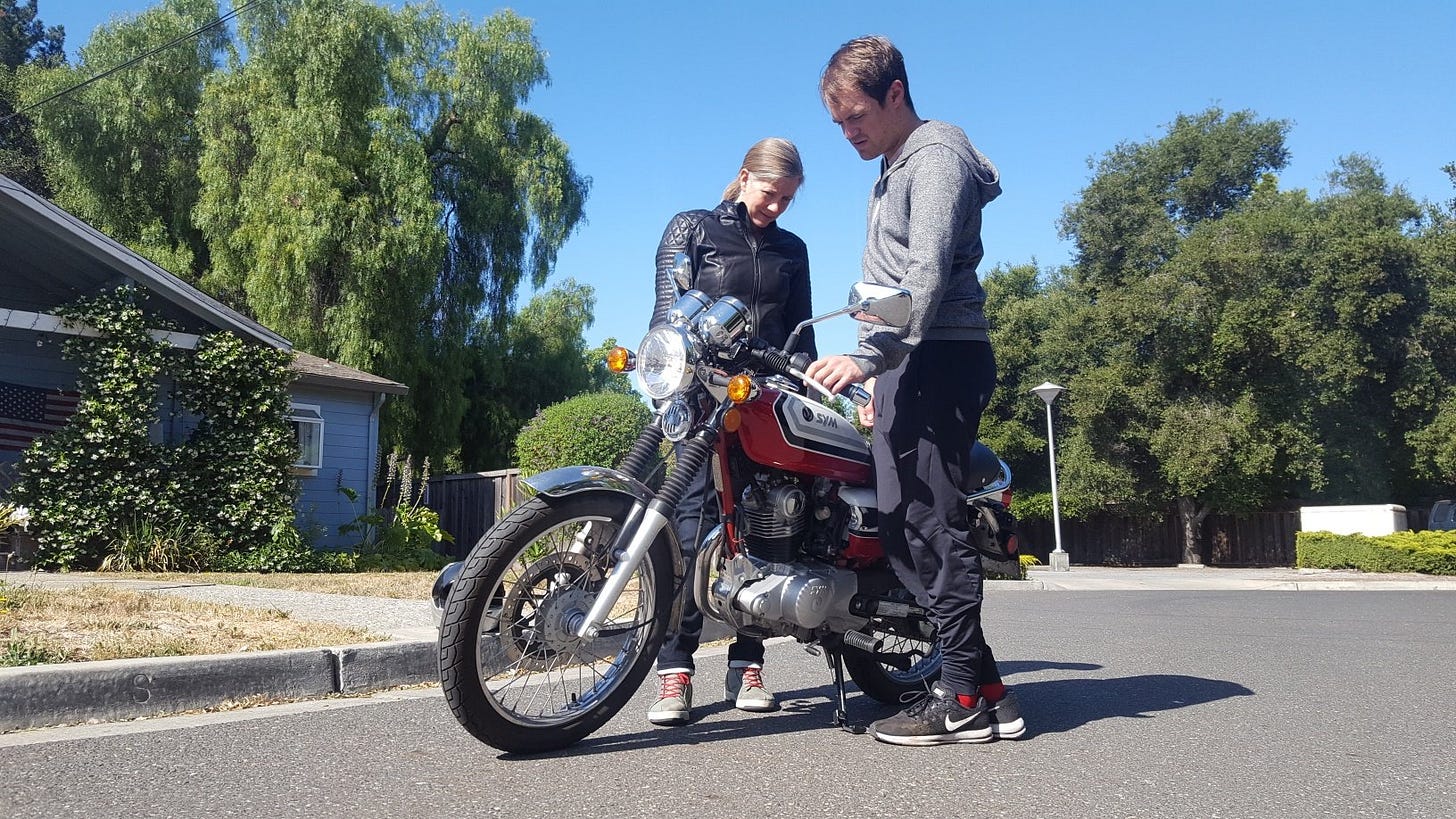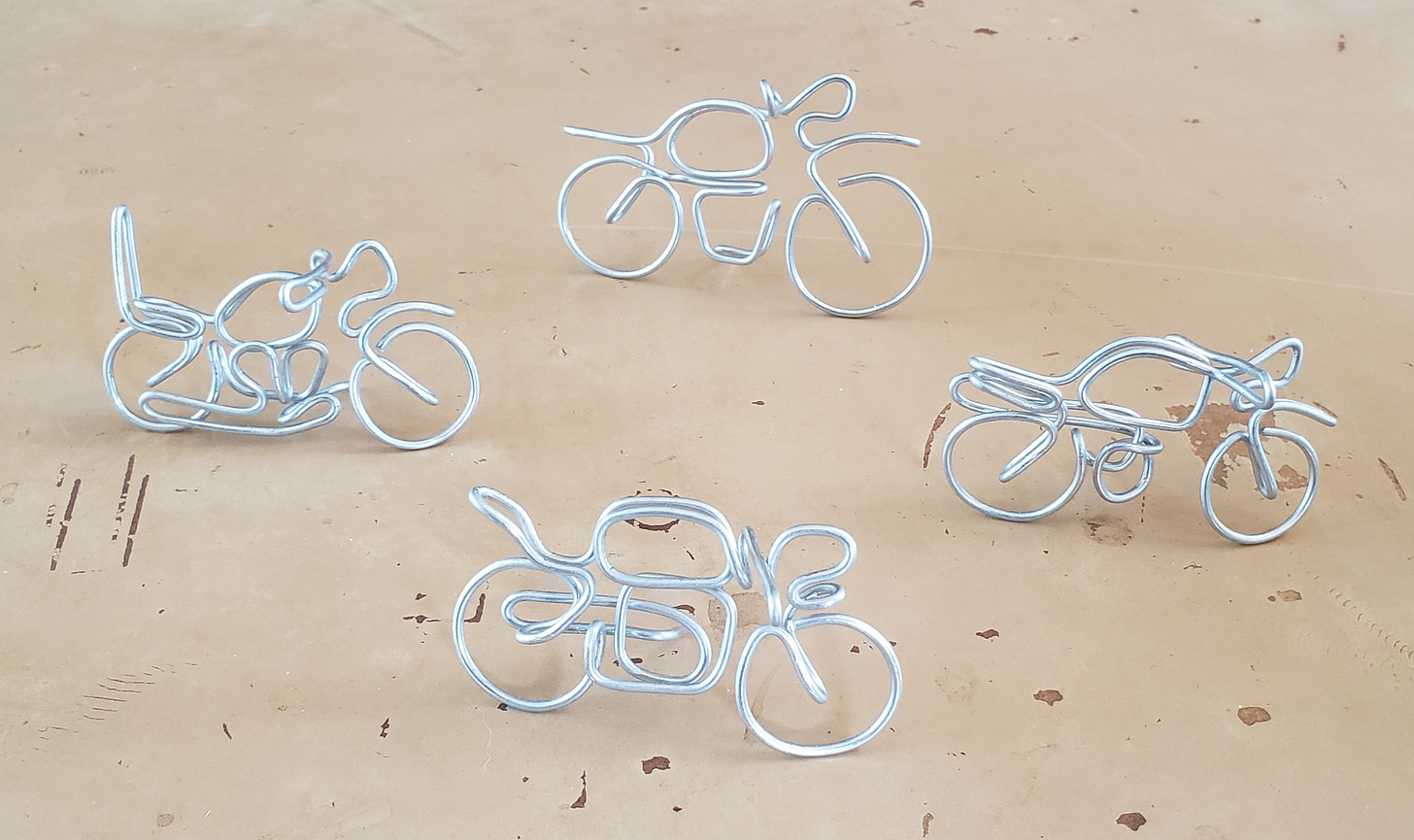The second child of yours truly, Henri Boulanger is a 26-year-old Wisconsin native with an artistic bent that includes songwriting, acting, painting, graphic design, wire sculpture and writing. My two arms are covered with four Henri-designed tattoos, and in addition to his day job as a barista, he designs merch for Red Rock Coffee. His artistic journey is a fun one to hear, so I’ll let him tell it.

Q: Do you remember the first time you drew a motorcycle?
I can’t actually remember the first time I drew a motorcycle, though I’ve always found it a tricky exercise. I can remember drawing bicycles as a kid and outlining the frame (always from the side) before drawing in two wheels as symmetrically and as round as I could manage.
Many of the motorcycles I admired as a kid fell either in the chunky camp of the Bat-Cycle or in the utterly abstracted camp of the speeder bikes ridden on the fourth moon of Endor. As such they’re somewhat difficult to describe as motorcycles when viewed, like hieroglyphics, in my childhood art.
Q: Several years ago you started giving me your pen and ink motorcycle drawings on cardboard for birthdays and Father’s Days. How did you choose which bikes to recreate?
When I drew the first one I wasn’t a very experienced rider, so I went mostly on raw aesthetic. I spent a lot of time on Bike Exif and other custom motorcycle aggregates, so a lot of what I saw was cafe, bobber, super clean, not always practical.
I trended toward the Guzzi’s we rode but by the time I drew later motorcycles I’d developed an appreciation for Vincents and their swooping exhausts as well as British bikes and their clean lines.
Q: Tell me about the bikes you’ve owned, the bikes you’ve ridden, and the bike you’d like to own someday.
I started off on an orange 1991 Honda Elite 80 scooter, which took me everywhere during my senior year of high school. At the time I didn’t have a car license and had mostly pushed my way around town on a fixie I’d had since middle school.
As I went into my freshman year of college I bought a black and gold 1982 Suzuki GS650G that had been lightly modified to be cafe racer-esque. The air-cooled inline four was heavy and something of a task to ride, with flipped bars that made my 19-year-old back hurt and silly tires that did not mesh well with California’s rain-grooved highways.
Selling this first motorcycle let me pick up a 1995 Honda XR250R that somebody in Santa Fe, New Mexico had slapped turn signals and a license plate on. Perfect for getting around and going on the occasional off-road romp. That was sold when I moved back to California, funding the purchase of my first new motorcycle, a 2015 SYM Wolf 150.
This purchase was a classic case of really wanting something specific and getting mild tunnel vision. You see, the 250 had been kickstart only, and I had once successfully started it with two inches of snow covering the engine block after leaving the cover off all night, leading me to the romantic notion that I should never be without that strenuous ignition option. This significantly diminished my choices, and I ended up with an incredibly lightweight 150 that’s proven perfect for getting to and from work, school, and anywhere reasonably close.

I’ve also taught five or so people how to ride on the bike, owing to its approachable height, unintimidating weight, and friendly retro looks. You and I share a 2004 Moto Guzzi California Stone 1100 and I can say it’s reliably my favorite motorcycle. Fast, smooth, comfortable.
I keep a list of motorcycles I’ve been lucky enough to ride, currently sitting around 42. Not all of the major brands, but enough to give me an idea of which styles appeal to me the most.
Oddly enough I don’t think that much about bikes I’d like to own up until I’m on the market. I think it’s the result of a discipline where I don’t check Craigslist unless I’m ready to buy (otherwise you always see the ‘perfect’ bike and it drives you nuts not being able to grab the ‘fleeting opportunity’). I’d love to do more off-road riding and I do miss having a bike I know can handle get chucked around in the dirt.
Q: You’re also an accomplished wire sculpture artist. Tell me about the time you were at Billy Al Bengston’s house for Christmas 2011.
One year we had Christmas in LA, spending time with family and meeting plenty of people in the process. Christmas Day we congregated at (Andy Warhol contemporary) Billy Al Bengston’s house for a Hawaiian themed get-together. Architect Frank Gehry was in attendance, as well as portraitist Don Bachardy. If you were searching for a pleasant party to share the company of elder artists in 2011 you couldn’t find much better.
I had brought my roll of aluminum baling wire, my trusty pliers, and a guitar. Between snacks I played Christmas songs and made little wire art pieces for guests, including a portrait that Don kindly reciprocated the next day by having me sit for a painting session. It was all fairly surreal and lovely.
Q: With motorcycle wire sculptures, how do you envision the finished artwork as you grab your tools and wire?
It depends on the scale. Recently I’ve begun designing tiny motorcycles; they’re as small as I can make them within the limits of the wire. People find them cute and I find the challenge enjoyable. A three-hour, two foot long piece I made several years ago was the result of a vacant afternoon and the challenge of recreating my little 150.
I began with the engine, building outward. It’s actually easier to use a single piece of wire unless the piece is hanging, so the design (and subsequent challenges) spiral out from a center point. It’s hundreds of little decisions, abstractions, and mess-ups with their individual fixes. The scale really determines whether I start with a roadmap or not.
The tiny motorcycles actually require more planning because of the tightness in the design. The bigger they get, the looser the planning.
Q: Our cross-country odyssey in 2018 was a visual and mental feast. Tell me how it felt putting in the miles heading west from Wisconsin to California. What were the highlights for you?
We rode almost entirely during the day, stayed in motels and hotels along the way, and stopped to see plenty of interesting things along our route. It was fantastic getting to see swaths of states I may otherwise not have visited, and it makes everything seem possible once you’ve got several thousand miles under your belt.
Some highlights were Beartooth Pass in Montana/Wyoming, the salt flats of Utah (and Speed Week), and the Grand Tetons. It was great getting a glimpse of all the little towns we stopped in and opened up the country for me.
If you’ve ever wanted to go on a large motorcycle ride—perhaps across the country—just do it. Get the time off, plan your route, and do it. I promise you it’s easier than you’d think.
Q: Red Rock Coffee hosted a moto-centric art show in January 2018. Tell me about the art you displayed, and what you’d like to create in 2021.
As I recall I displayed the larger wire motorcycle and a few drawings I’d made as gifts. It was fun getting to talk with folks who rode and to get their take on the artwork. Most of the time I create things for myself and they make me pretty happy, but once in a while it’s fun to have an affirming conversation with a fellow rider and art appreciator.
In 2021 I’d like to make more repeated designs, iterating on an idea and getting more and more advanced. It’s fun doing one-off pieces, but re-approaching a concept is always gratifying when you can make it just a bit cleaner, bolder, and better.
I may start selling my wire art, which would be a different beast entirely. Commissions and repeated, almost product-like designs sound fun but very different from the little doodles I usually make.













